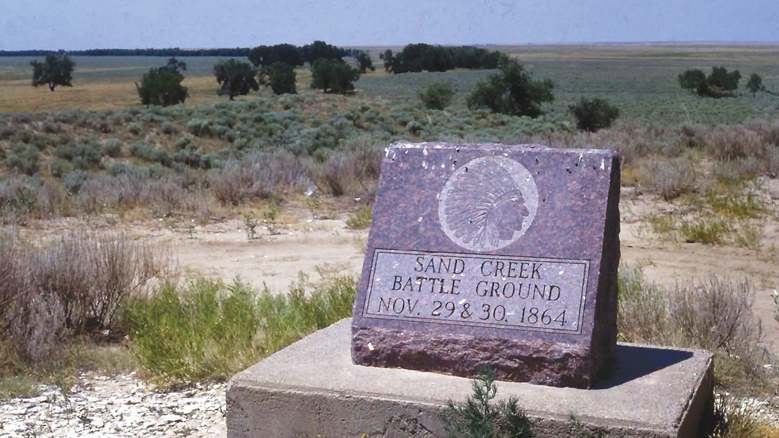
There is a way that Nature speaks, that land speaks. Most of the time we are simply not patient enough, quiet enough, to pay attention to the story. —Linda Hogan, Chickasaw
I travel in Quaker ministry with a concern for seeking right relationship with Indigenous peoples. In my workshops I ask people to think about our country’s history of genocide and colonization, which we don’t think about very much, our schools don’t teach very much, and our government never acknowledges. I ask people to think about what happened here. I then ask them about Native people in our communities today and ask what we might do to develop relationships that are based on truth, respect, justice, and our shared humanity. Many people say they don’t know any Native Americans. This might be true, or it might not be: Native people are not always recognizable. But what is true is that many of us don’t feel any connection with Indigenous people. It’s hard to start to imagine what it would mean to work toward “right relationship” with them.
I think the land can be our connective tissue. Most of us are connected to land somewhere: the land where we live today, the land of our ancestors, the land where we were born, the land where we vacation, the land we love for whatever reason. On the North American continent, all the land we know and love was known and loved first by Indigenous people. And Indigenous people say the land remembers.
If the land we love could tell us what it remembers, what would it say?
If the land we love could tell us what it remembers, what would it say?
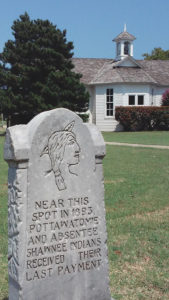
When I asked myself this question, I started by thinking about the land where my German ancestors settled in the 1840s. They bought land in Michigan Territory and founded a German Lutheran town they named Frankenmuth, the “courage of the Franconians.” The fertile land of Central Michigan had supported a very large Native population until it was wrested from them by the 1819 Treaty of Saginaw a couple of decades before my ancestors arrived. The territorial governor, Lewis Cass, promised the Chippewas that they could remain on smaller tracts of land in Michigan “forever.” After Cass became secretary of war under President Andrew Jackson, he was put in charge of enforcing the 1830 Indian Removal Act. He broke his promise to the Chippewas and forced most of them to move west. Some of this land became my family’s farm. It lies along the Cass River, named for Lewis Cass, the primary agent of Indian removal. This is the land where I played with my cousins during summer vacations, the land where my cousins still live.
My parents and my cousins didn’t learn this history in the Frankenmuth schools. My 98-year-old father and I learned it together by searching the Internet for a few hours. What does this history mean for my family? What does it mean to the Chippewas, expelled from Michigan and now spread out across the Dakotas? I don’t have clear answers to these questions, but I know that the land remembers, and I know that somehow the Chippewa people and my family are bound together in the story of this land.
One way has already come to light: Jerilyn DeCoteau, the Native American woman who works most closely with me in the Toward Right Relationship with Native Peoples project, is an enrolled member of the Turtle Mountain Band of Chippewa Indians. She grew up on the Turtle Mountain Reservation in North Dakota. We had been working together for six years before we realized that some of her people had been removed from Central Michigan so that my people could make farms there. Jerilyn and I are related through the land. There is something awesome, terrible, and beautiful about acknowledging this as we work together.
My parents moved to Valparaiso, Indiana, where I was born. The federal government purchased Paradise Valley (the land that became Valparaiso) from the Potawatomi leader Chiqua. In 1838, a mounted militia drove Chiqua and 860 Potawatomi people out of Northern Indiana and across the Mississippi River into Kansas. The Potawatomi remember this as the Trail of Death. My family doesn’t remember it at all; we didn’t learn it in Valparaiso schools. I returned to Valparaiso as a college student to study at Valparaiso University. I didn’t learn this history in my college courses either. But the land remembers, and through it, I am bound together with the Potawatomi people.
Iwish I had known this when Sante Fe Friend Guthrie Miller and I traveled through Oklahoma a few years ago, visiting the sites of some of the Quaker Indian boarding schools. We walked around a historic Quaker church that is maintained by the Citizen Potawatomi Nation. The boarding school there, where Quakers labored to assimilate Potawatomi children, is no longer standing. I’m sorry that I didn’t know at the time how my family was connected to the Potawatomi people through the place in Northern Indiana where we both come from.
My family moved to Colorado in 1957, and now I live just outside the city of Boulder. The Boulder Valley is the homeland of the Arapaho people. This is recognized in the 1851 Treaty of Fort Laramie. When miners discovered gold in the Boulder foothills in 1859, the Arapaho were forced out of their camps in the Boulder Valley. Their peace chief, Nawath, was told to camp on the eastern plains at Sand Creek, where the U.S. Cavalry attacked them at dawn one November morning. More than 200 people, most of them women, children, and elders, were slaughtered in what became known as the Sand Creek massacre. Reflecting on this history, the Pawnee attorney Walter Echo-Hawk wrote: “The land can speak to those who listen. . . . There is a bluff . . . overlooking Sand Creek where you can hear women and children crying in the wind.”
Boulder was one of the training sites for volunteer cavalrymen, and more than 50 Boulder men helped carry out the Sand Creek massacre. The Arapaho survivors were forced out of Colorado to reservations in Wyoming and Oklahoma, where most Arapaho people live today.
I wasn’t alone in learning this history of the place I call home. Three years ago, a group of Native and non-Native people in Boulder started meeting to learn about the area’s Indigenous history. We sought out the only Arapaho person we knew of who lives in Boulder today. Her name is Ava Hamilton. We told Ava we thought we’d like to invite some Arapaho people to come to Boulder to meet with us. Ava said, “Well, that wouldn’t be the way to start. You need to go meet with them where they live now—in Oklahoma and Wyoming.”
We raised money to make the trips, and Ava came with us and set up meetings with Arapaho elders and government leaders. When we asked them how they remembered Boulder, every single person said, “Boulder? Boulder is home. Boulder is our home.” Most of these people had never been to Boulder, but they remembered. “Our ancestors lived in Boulder, and they died in Boulder. Boulder is sacred ground to us—our homeland.” When we asked how they would like to relate to the land and the people who live in Boulder now, they said they would like to have land in Boulder: a private place, a reverent place, where they can pray, where they can honor their ancestors. They wanted a place to give their children a sense of what their lives were like before—when the Arapaho people were free. They also told us they would like to educate the people of Boulder about their lives today, how they are struggling to maintain their language and celebrate their culture, the challenges their young people face, and the knowledge and stories of their elders. They want us to know they’re still here.
We told them Boulder has a celebration of Indigenous Peoples Day in October, and they agreed that would be a good time for them to come. They said they’d like their dancers to perform and their elders and leaders to give presentations about all aspects of their lives: their governments, their games, their language, their arts, their daily lives. They wanted to meet with city officials to talk about land, with school administrators to talk about curricula, and with faith communities to get to know some Boulder families face to face.
We raised money to bring Arapaho delegations from Wyoming and Oklahoma to Boulder to meet with us in June 2018. During their two days with us in Boulder, city and county government officials took us out to see several large parcels of city and county open-space land that they thought might be appropriate for private use by the Arapaho and other Native peoples. One parcel is the site of the fort where Boulder’s volunteer soldiers mustered to carry out the Sand Creek massacre. Another has stone circles that date back to 500 years B.C.E. Native people have lived in the Boulder Valley for a very long time. Chief Elvin Kenrick sang memorial songs, gave offerings, and said prayers at these sites.
Later we walked together along creeks where the chokecherries were in bloom—the same chokecherries that Arapaho people had gathered here centuries ago. Then Boulder churches (Unitarian Universalists, Quakers, and members of the United Church of Christ) provided a potluck dinner with elk stew, buffalo burgers, and chokecherry jam as well as the typical Boulder vegan fare, and we relaxed in fellowship together over a shared meal.
In our first meetings with the Arapaho when we visited them in Wyoming and Oklahoma, they had expressed some concerns about how they might be treated if they came to Boulder. Would their children be safe? Would their elders be respected? During their first visit with us in Boulder, the Arapaho delegates felt safe and welcomed.
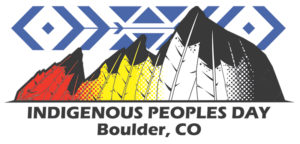 Around 100 Arapaho people came to celebrate Indigenous Peoples Day with us. We were able to provide gas mileage, food, and lodging for them as well as gifts and honoraria for their traditional dancers and drummers. They organized the day’s events, which started with a Christian worship service officiated by Chief Elvin Kenrick and included familiar hymns like “Amazing Grace” led by two singers and sung in the Arapaho language. Some Boulder people were surprised that the Arapaho would want to offer a Christian church service, but this was a reminder that Native people have been colonized and Christianized for more than five centuries, and that many Native people find ways to honor their traditional ceremonies and be Christian at the same time.
Around 100 Arapaho people came to celebrate Indigenous Peoples Day with us. We were able to provide gas mileage, food, and lodging for them as well as gifts and honoraria for their traditional dancers and drummers. They organized the day’s events, which started with a Christian worship service officiated by Chief Elvin Kenrick and included familiar hymns like “Amazing Grace” led by two singers and sung in the Arapaho language. Some Boulder people were surprised that the Arapaho would want to offer a Christian church service, but this was a reminder that Native people have been colonized and Christianized for more than five centuries, and that many Native people find ways to honor their traditional ceremonies and be Christian at the same time.
After church and for the rest of the day, more than 600 Boulderites filled the high school gym. They cheered and applauded as local government leaders welcomed our Arapaho guests and as Arapaho elders and government leaders spoke to us in a language that had resonated throughout the Colorado mountains and plains for many centuries, long before a word of Spanish or English was ever heard. Stephen Fast Horse, a member of the Northern Arapaho Business Council, told us:
The Boulder area was the chosen place for the Arapaho people in a spiritual sense. Our ancestors had a spiritual quest to search for a certain place, and when they came here they knew they had found it. It was foretold to us by the higher being of life. The Creator has always led our people. Our hearts always yearn for our original homeland. We’ve never before been invited back to this area that we hold so dearly. It’s a heartfelt emotion for us. We hope we will continue to be welcomed in this place that we belong to.
We are related through the land. Wherever we live, how can we begin to acknowledge this; to celebrate it; to work toward a relationship with Native people based on truth, respect, justice, and our shared humanity?
We welcomed the Arapaho people again last October for a second all-day celebration of Indigenous Peoples Day. This year our organization, Right Relationship Boulder, will bring Arapaho elders to give presentations in our elementary schools and host an Arapaho language camp for Arapaho youth here in their homeland. We continue to work with government officials to improve public education and recognition of Indigenous peoples’ history and presence in the Boulder Valley, and—perhaps most important—we continue to educate ourselves.
The land of the Boulder Valley is bringing together all the people who love that place. It is helping us uncover hidden connections, calling us to know that we are bound together, related through the land. Now, when I walk along the creeks in my neighborhood or on trails in the foothills, I remember the people who walked those paths before me, and now I am friends with some of their descendants. There is pain in our shared history. And there is hope.
We are related through the land. Wherever we live, how can we begin to acknowledge this; to celebrate it; to work toward a relationship with Native people based on truth, respect, justice, and our shared humanity? What difference would it make for the descendants of the people who first loved this land and for all the rest of us?







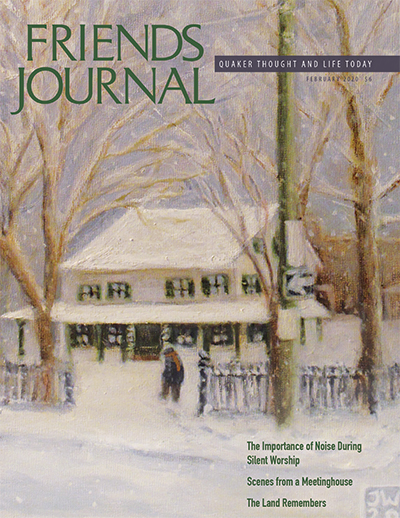
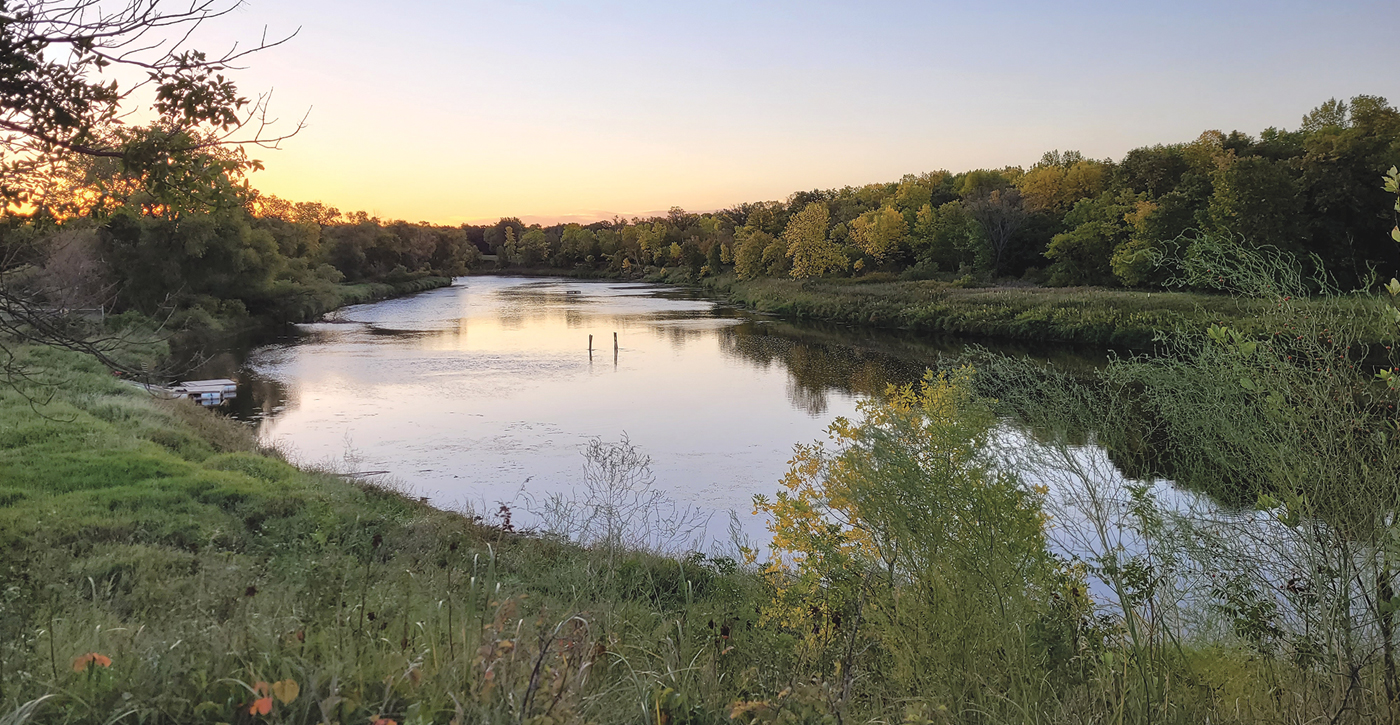
Thank you Friend Paula, for sharing.
May you inspire more Friends to explore the history of the land where we now live.
Dear Friend & Estimada Amiga Paula,
I am delighted to learn of you! I hope we can communicate and share our thoughts & ideas!!!!
I have been led to devote most of my life to living with and filming the Totonaco indigenous people of Mexico.
Please visit my website, and watch a few trailers. One film is free – http://docfilm.com/site/cumbre-tajin/.
I am a member of the Rochester, NY Meeting, and an attender at the Junta de Amigos in Mexico City.
Please let me hear from you!
Con Muchos Saludos,
Bruce, it’s great to learn about your work too — and what an amazing festival and film (Cumbre Tahin). It’s so important to lift up the present realities of Indigenous peoples in all parts of the world. We are all enriched as we learn from each other. Muchos saludos, -Paula
I love the story you have related and I’m sending it to a native friend of mine. It holds promise. Thanks.
Paula, your story goes to the heart. It quietly unfolds the sense of presence in which the memory of the land comes alive. So much desecration, so much weeping, so much silence. The story of your devotion to the path of right relationship is like a prayer flag in the wind.
With much appreciation.
Keith Helmuth
Keith, it’s nice to hear from you. I remember meeting many years ago at FCUN/QEW gatherings, and I appreciate your soulful and skillful dedication to Earthcare. With warm greetings, -Paula
Thank you, Paula.
Your writing reminds me of some of my experiences with Ojibwe (Chippewa), Lakota (Sioux), Seminole, and Mikkosukee people. Their reverence for the land was a common thread that has changed my own thinking.
I was once employed by an Indian-run health clinic in Minneapolis. When talking with Native adults and children, I remember learning to prioritize listening over speaking.
I learned that when a Native person expressed in interest in seeing me, it did not mean that they wanted to converse. It meant that they would like to be in my presence.
I began trying to observe and listen more carefully in natural settings.
Back then, an Ojibwe friend would occasionally travel from the Red Lake reservation to visit a relative in the Twin Cities, and he would also look me up. We enjoyed hiking together, often along stretches of the Minnesota River that were not easily visible from the city.
The pauses in our conversation might have baffled others, but they were comfortable for us. We were present with each other, and with the natural world.
Thank you for this beautiful and healing story. We should all follow in your footsteps.
Thank you, Paula, for your dedication to this sacred work you are doing. There is much healing that needs to happen. The connection we share with the land is,indeed, our bond.
Kathy
Cambridge UK
I send deepest Quaker greetings from far away. On Christmas Day 1944, when I was a little over one year old and we were at war with Nazi Germany, my parents, grandmother and aunt invited two American or Canadian servicemen for Christmas lunch. They turned out to be Native American or Canadian. They nursed me and gave me a native name which translated into Little Star.
As soon as I was old enough to understand about this special meeting I became deeply attached to Native Peoples. I soon discovered the horror of their treatment by European settlers. I know about the Pebble Hill seminars to bring Quakers closer to understanding their guilt in setting up the Residential Schools. I pray that Quakers and the First People continue on the right path along with white non – Quakers.
May the light shine on you Pauline
David
A thoughtful article. It made me think of this place where I sit and read. It’s about a mile from Grand Traverse Bay on Lake Michigan. Although I am in a city, I am surrounded by white pines and enormous oaks.
This was, and still is for some, the home of the Anishnaabe who used to gather on the white sand beaches of the Bay and lived from this land where I now live.
Over a long lifetime I have known many Anishnaabe people. My feelings now are a mixture of gratitude and sorrow. I am so glad to live here and so sorry for the pain of others. As always, I wonder what can I do now?
Dear Sharon,
Ah, yes, I know that stretch of Lake Michigan beaches well! As to your question, “What can I do now?”, would you like me to make a suggestion or two? In your own community/region, you can find out about Native American organizations, support them, and participate in their activities. When I was doing graduate work at Michigan State, I went to wonderful powwows at colleges and universities that raised funds to support scholarships for Native American students. To learn how Quakers in the U.S. and Canada are working toward right relationship with Native peoples, see these websites: friendspeaceteams.org/trr and decolonizingquakers.org. And your gratitude for those white pines and enormous oaks mingles with the prayers of gratitude that have been rising from those shores for thousands of years. Blessings. –Paula
So beautiful Paula.
The gathering last year meant so much to me, and I am eager to participate again this year.
Molly
Hello..or in our language women say Tous.. I am a direct descendent of the sand creek massacre..I amalso a dirwct descendent of our last war chief.. Sharpnose..I am attending school here in colorado to further educate myself. Sharonose knew he had to stop thebviolencw nd fight or we wud cease to exist.especiakky after the massacre ..my gm raised us and wud say an educated native is a dangerous native. And the pen was mightier than the sword .nd that we wud have to be educated and learn to win battles in less violent ways and to also choose our battles .we can’t bark back at every dog who barks at you she wud say ..iurvwnviirnment growing up was violent and survivalbsortavdependedbonnitmso hére I am .trying to build an educated life but the struggle and cost of livingbherrvis dare I say.msurreal..especjat for a poor nativeike myself ..smh .maybe I. Cud go BK home and get educated online….hmmm. where is the reservations for natives from reservations lol..frfr